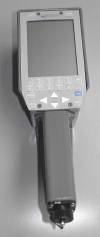Feb. 28, 2003 – Matrics, an RFID equipment provider in Columbia, Maryland, has introduced a new handheld RFID reader and revealed plans to market the first fixed RFID reader that handles tags based on the Auto-ID Center’s Class 0 and Class 1 specifications.
Matrics says its handheld can read up to 200 tags per second at a read range of up to 10 feet. Most UHF handheld readers operating in the UHF range have a read range of two to three feet. “That’s huge in terms of efficiency because you can step back from items and scan fairly aggressively,” says Matrics CEO Piyush Sodha.
Sodha describes the handheld as an important bridge technology for companies implementing RFID. “Imagine a retail environment where clothes are hanging and you want to scan them without installing fixed RFID readers throughout the whole store,” he says. “A clerk can go around and scan the racks and see what’s there. It’s a rapid deployment tool.”
The Matrics handheld uses the Windows CE.net operating system and works with Class 0 RFID tags. It connects to a host computer via a USB v1.1 high-speed serial bus and supports wireless LAN connectivity via an optional 802.11b wireless network interface with 128-bit data encryption.
Matrics has also introduced a new fixed reader, called Advanced RFID Reader. It’s designed to function with any standard UHF RFID tag, including Class O and Class 1. The reader could support for ISO 18000-6 if there is a demand for it.
“It future-proofs you from variations in standards,” says Sodha. That is, companies can invest in reader technology without worrying about which type of UHF tags become dominant. The reader’s software can be configured to enable it to support new standards as they emerge.
Matrics says the reader can read more than 1,000 tags per second at a read range of up to 30 feet. It also features built-in memory to enable local tag buffering; several options for connecting to a network, including 802.11b; and enhanced support for multiple antennas.
The handheld will be available from April. The fixed reader will begin shipping in June. The company hasn’t released pricing yet for either unit.
During the Auto-ID Center’s board meeting in Atlanta this week, Matrics also did a technology demonstration as part of the Auto-ID Center’s certification process. The company demonstrated the capabilities of the Class 0 specification.
Sodha says a number of companies, including Rafsec, Symbol and Tyco all expressed plans to support the Class 0 specification. Matrics is currently the only company making Class 0 tags, and its reader is the first to support both Class 0 and Class 1 tags.


